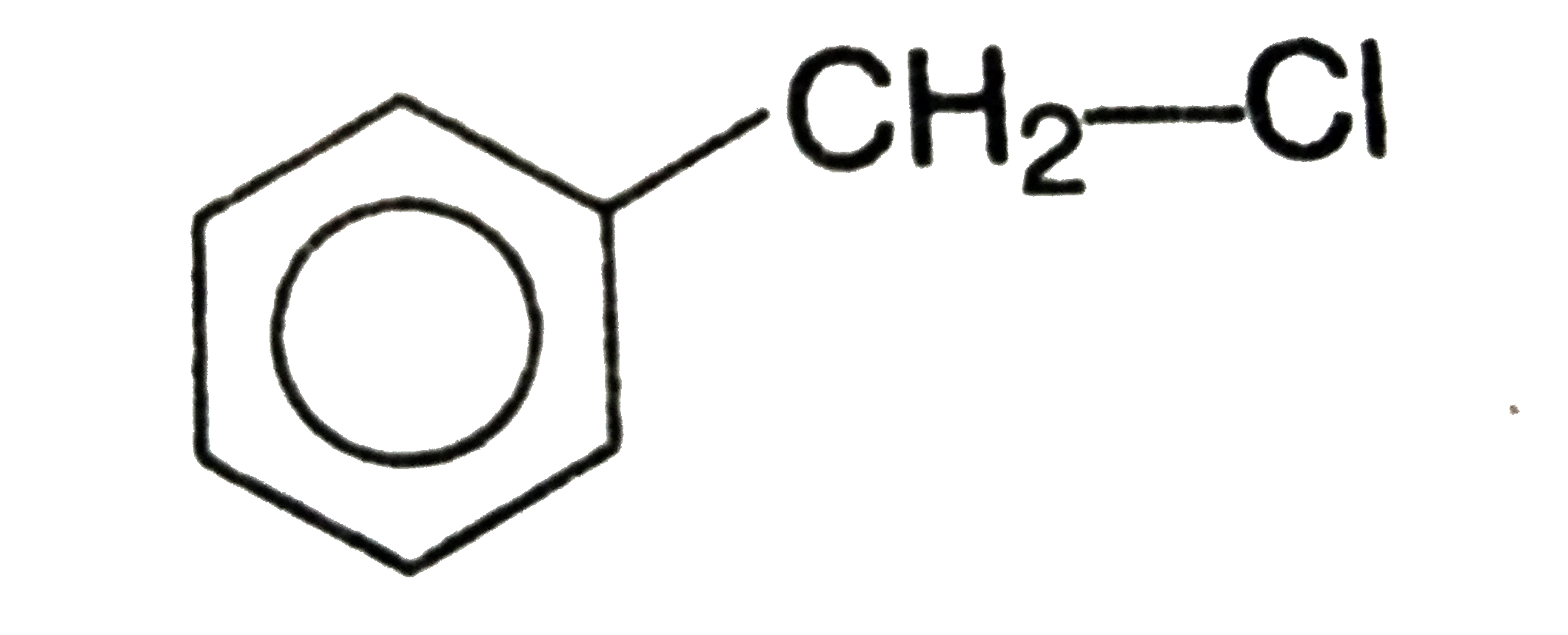Chlorobenzene and benzyl chloride can be distinguished by boiling with aqueous KOH followed by acidification with dil HNO3 and subsequent treatment with AgNO3 solution.
To distinguish between chlorobenzene and benzyl chloride, we can follow a systematic approach using aqueous KOH, dilute HNO3, and AgNO3. Here’s a step-by-step solution:
Step 1: Reaction with Aqueous KOH
- Chlorobenzene: When chlorobenzene is treated with aqueous KOH, no reaction occurs because the chlorine atom is bonded to a sp² hybridized carbon, which is part of an aromatic ring. The resonance stabilization of the aromatic system prevents nucleophilic substitution from occurring.
- Benzyl Chloride: In contrast, benzyl chloride (which has a primary carbon attached to the chlorine) reacts with aqueous KOH through an SN2 mechanism. The KOH acts as a nucleophile and attacks the carbon, leading to the substitution of the chlorine atom and forming benzyl alcohol.
Step 2: Acidification with Dilute HNO3
- After the reaction with KOH, the solution is acidified with dilute HNO3. This step is crucial because HNO3 acts as an oxidizing agent.
- Benzyl Alcohol: The benzyl alcohol formed from benzyl chloride is oxidized by HNO3 to form benzaldehyde.
Step 3: Treatment with AgNO3
- Finally, the solution is treated with AgNO3.
- Benzyl Chloride: Since benzyl chloride was converted to benzyl alcohol, and then oxidized to benzaldehyde, the chloride ion (Cl-) is released into the solution. When AgNO3 is added, it reacts with the Cl- ions to form a white precipitate of AgCl.
- Chlorobenzene: In the case of chlorobenzene, since no reaction occurred with KOH, there are no Cl- ions released. Therefore, when AgNO3 is added, no precipitate forms.
Conclusion
- The formation of a white precipitate indicates the presence of benzyl chloride, while the absence of a precipitate indicates chlorobenzene.
Summary of Results
- Chlorobenzene: No precipitate with AgNO3.
- Benzyl Chloride: White precipitate (AgCl) with AgNO3.
- Chlorobenzene: When chlorobenzene is treated with aqueous KOH, no reaction occurs because the chlorine atom is bonded to a sp² hybridized carbon, which is part of an aromatic ring. The resonance stabilization of the aromatic system prevents nucleophilic substitution from occurring.
- Benzyl Chloride: In contrast, benzyl chloride (which has a primary carbon attached to the chlorine) reacts with aqueous KOH through an SN2 mechanism. The KOH acts as a nucleophile and attacks the carbon, leading to the substitution of the chlorine atom and forming benzyl alcohol.
- After the reaction with KOH, the solution is acidified with dilute HNO3. This step is crucial because HNO3 acts as an oxidizing agent.
- Benzyl Alcohol: The benzyl alcohol formed from benzyl chloride is oxidized by HNO3 to form benzaldehyde.
- Finally, the solution is treated with AgNO3.
- The formation of a white precipitate indicates the presence of benzyl chloride, while the absence of a precipitate indicates chlorobenzene.
- Chlorobenzene: No precipitate with AgNO3.
- Benzyl Chloride: White precipitate (AgCl) with AgNO3.
Topper's Solved these Questions
- HALOALKANES AND HALOARENESBOOK - MODERN PUBLICATIONCHAPTER - HALOALKANES AND HALOARENESEXERCISE - MEMORY TEST (B. Complete the missing links)
11 Videos
- HALOALKANES AND HALOARENESBOOK - MODERN PUBLICATIONCHAPTER - HALOALKANES AND HALOARENESEXERCISE - MEMORY TEST (C. Choose the correct alternative)
11 Videos
- HALOALKANES AND HALOARENESBOOK - MODERN PUBLICATIONCHAPTER - HALOALKANES AND HALOARENESEXERCISE - NCERT examplar Problems (Assertion and Reason Type Questions)
10 Videos
- EQUILIBRIUMBOOK - MODERN PUBLICATIONCHAPTER - EQUILIBRIUMEXERCISE - Unit Practice Test
13 Videos
- HYDROCARBONSBOOK - MODERN PUBLICATIONCHAPTER - HYDROCARBONSEXERCISE - UNIT PRACTICE TEST
15 Videos
Similar Questions
when benzyl chloride is boiled with aqueous KOH solution and the solution is acidified by a few drops of dilute HNO3 followed by AgNO3 solution, a white precipitate is formed. However, no such precipitate is noticed when the reaction is carried with chlorobenzene. explain.
View SolutionWhich of the following will give yellow precipitateon shaking with an aqueous solution of NaOH followed by acidification with dil. HNO3 and addition of AgNO3 solution?
View Solution
Knowledge Check
Which of the following will give yellow precipitate on shaking with an aqueous solution of NaOH followed by the acidification with dil. HNO3 and addition of AgNO3 solution?
A B
B C
C D
D
Which of the following will give yellow precipitate on shaking with an aqueous NaOH followed by adification with dilute HNO3 and addition of AgNO3 solution.?
A B
B C
C DNone of these
DNone of theseWhich of the following will give yellow precipitateon shaking with an aqueous solution of NaOH followed by acidification with dil. HNO3 and addition of AgNO3 solution?
A B
B C
C D
D
Which of the following will give yellow precipitate on shaking with an aqueous solution of NaOH followed by acidification with dil. HNO3 and addition of AgNO3 solution
View SolutionReagents that cannot be used to distinguish allyl bromide from n-propyl bromide are
I. Br2Cl4
II. shaking with an aqueous solution of AgNO3
III. boiling with aqueous KOH solution followed by acidification with dil. HNO3 and addition of AgNO3 solution
IV. fusion with Na followed by acidification with dilute HNO3 and addition of AgNO3 solution
Select the correct option
View SolutionAn organic halide is shaken with aqueous NaOH followed by the addition of dil HNO3 and silver nit rate solution gave white ppt The substane can be .
View SolutionBenzene reacts with acetyl chloride in the prescence of anhydrous AlCl3 to give
View SolutionWhich of the following compound will give yellow ppt. on shaking aqueous solution of NaOH follwed by acidification and addition of AgNO3 solution ?
View Solution